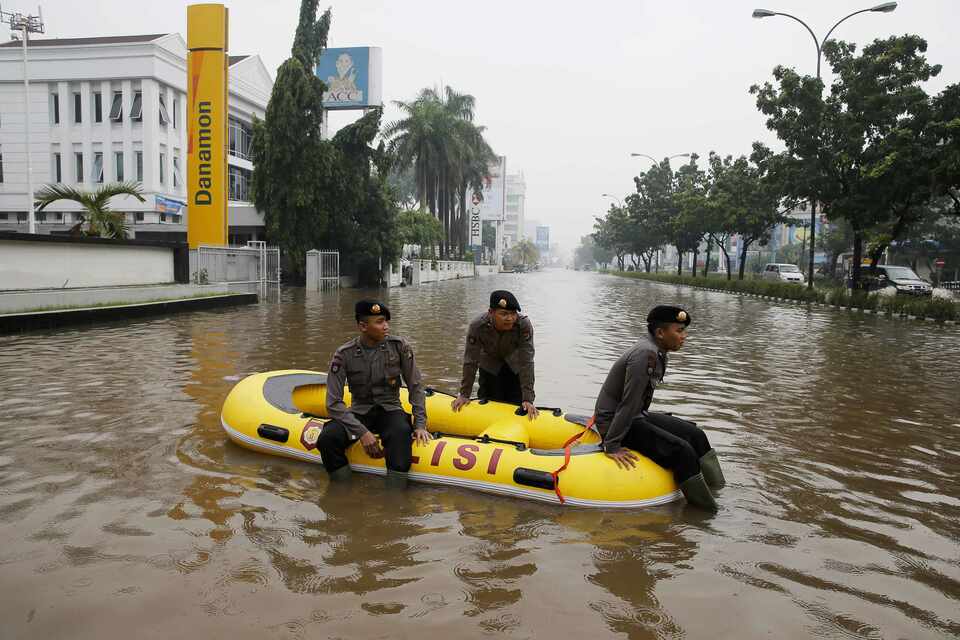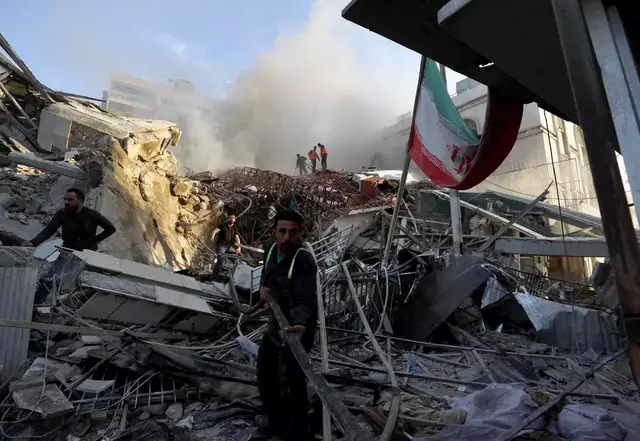A Tweeting Solution to Jakarta Flooding

Jakarta. In February 2007, Jakarta experienced its worst flooding in over three centuries.
More than half a million people were evacuated from their homes, destruction of property totalled at $453 million, and 80 people died as a result of drowning, electrocution and the inevitable collapse of homes, trees, street lights and other structures.
Six years later, in January 2013, disaster struck again.
After being besieged by almost 50 percent more rain than in the previous year, at least a third of Jakarta’s streets were submerged during the resulting floods; and once again, the human costs were high.
More than 90,000 people were evacuated from their homes, and 38 people died amid the deluge.
So far this year, Jakarta has been fortunate enough to escape the torrential downpours of 2007 and 2013, but the challenge still remains: How will Jakarta survive its annual flooding in years to come, as population growth remains high, urbanization continues unabated, and climate change continues to deliver intense and unpredictable weather events?
Dr. Etienne Turpin, an urban theorist based at the University of Wollongong in Australia, has been grappling with this question for several years, and has come to the conclusion that if Jakarta’s megacity, Jabodetabek, is to survive the 21st century without a yearly flood massacre, then each of its 28 million citizens must become an active part of the city’s flood defense system, not merely passive spectators to it.
Turpin is a co-director of PetaJakarta.org, a pioneering website that is helping to breathe new life and new technology into Jakarta’s ageing and increasingly inadequate flood defenses.
PetaJakarta.org was officially launched at City Hall last month, during a ceremony with Governor Basuki Tjahaja Purnama, Mark Gillis of Twitter, and large media fanfare. The project’s mission is to experiment with new ways of improving “urban resilience” in the Indonesian capital, and to promote sustainable adaptation to the effects of climate change.
Speaking to the Jakarta Globe at his project office, Turpin is unequivocal about the existential threat posed by climate change to Jakarta in this century: “Of all the challenges faced in the 21st century,” he says, “coastal megacities in South and Southeast Asia are under the greatest pressure.”
“If human beings want to continue to live in Jakarta, they are going to need to adapt climate change,” he adds. “This is not just sea level rise, but also erratic, extreme weather and more intense precipitation. No one is coming to fix these climate problems. We have to adapt to avoid fatal consequences.”
How tweets can save lives
Flood prevention may be a noble and necessary enterprise, but with climate change poised to bring to more rain and higher sea levels, mitigation alone is doomed to be a losing battle.
With this in mind, Turpin and his team of researchers see hope in the potential for ordinary Jakartans to participate in flood detection and share their knowledge through geosocial intelligence.
Such data sharing allows citizens and emergency services to visualize flooding as it happens, so that dangerous inundations can be identified in real time, and damage can be avoided.
“In working with emergency response to extreme weather and climate change, what we want to visualize are things that allow evidence-based decisions to be made, and patterns to be discerned,” Turpin says. “We also help the public to navigate risks and participate in response in a more effective way.”
So how does the platform work, and how can ordinary Jakartans get involved?
Quite simply, anyone who owns a smartphone and knows how to tweet is already fully trained and fully qualified.
PetaJakarta.org builds up its database by crowdsourcing flood-related tweets sent from within the Jakarta area, which are then compiled and mapped out in real time using geotagging technology.
Any tweet with the hashtag #banjir (flood) and mentioning @petajkt will be automatically processed to an interactive, live map, which can be accessed for free at PetaJakarta.org.
“This a first-in-the-world partnership, where Twitter is supporting us with direct access to its data, so that users can support emergency response to flooding,” Turpin says.
From a technological point of view, Turpin believes that Twitter offers the “best existing social media infrastructure to assist in civic co-management, and assist with urban emergency response.”
With more than 10 million Twitter users currently tweeting from Jakarta — more than any other city on Earth — there is perhaps no better place to experiment with a social media-based emergency response platform.
Additionally, Twitter provides the immediacy that can be crucial for disaster response, and is easy to use.
“We hope this will become a habit, a kind of social civic responsibility,” Turpin says. “There’s no app, there’s nothing to download ... You just copy @petajkt into your tweet when you’re telling someone what’s going on, and then use the map to navigate the floodwaters.”
When asked how the partnership with Twitter and the idea for PetaJakarta.org came about, Turpin responds with an unlikely reference to the famous “Oscars selfie.”
“The most viewed tweet in history had over 3.5 billion impressions ... and it was a selfie from the Oscars!” he says. “We thought: Okay, that’s great, but we could do something more interesting with the social infrastructure of Twitter. We could save lives, not just share selfies of famous people.”
Heroic engineering vs geosocial intelligence
The success or failure of a platform such as PetaJakarta.org depends entirely on ordinary citizens; if the public fails to participate, then lives will be put at risk, and preventable deaths are sure to occur.
The only alternative left to citizens is to rely entirely on the government for protection from flooding, by building higher walls and tougher embankments.
Like many urban theorists in the age of climate change, Turpin is skeptical about the ability of governments to deliver sustainable and long-term solutions to the effects of climate change unless they engage with citizens.
“Heroic engineering,” as he likes to call it, has reached its sell-by date, and must now give way to more affordable, accessible, and sustainable geosocial intelligence systems that promote cooperation and data sharing between ordinary citizens and emergency services.
“If you ask an engineer what to do about the floods, he’ll say ‘Well, build bigger damns, build bigger canals, just build bigger infrastructure,’” Turpin says.
“But in the context of global climate change, especially in the tropics, bigger infrastructure isn’t the solution. It increases the likelihood of corruption, it often lacks the budget for maintenance, and it fails to address the real cause of the problem.”
Frank Sedlar, a hydraulic engineer and visiting researcher at PetaJakarta.org, shares Turpin’s skepticism on the topic of “heroic engineering.”
Speaking about the feasibility of Jakarta’s forthcoming Giant Sea Wall, which promises to be the world’s largest and most expensive feat of civic engineering ever attempted, Sedlar says the project “makes perfect sense from a hydraulic engineering point of view, but the only problem is scale.”
“I think it’s could buy Jakarta a few more years [of survival], but in the end, it’s just a putting a very big, very costly band-aid over the problem — which is certainly going to resurface [in future],” he says.
Turpin added that an engineering solution in one area often leads to a new engineering problem in another: “Addressing the rising sea levels and land subsidence,” for instance, “does not address the problem of problematic flooding coming from the south, or from more intense rainfall.”
“Integrated, engaged proposals are needed, and the public should debate their merits and costs,” he adds. “Who is going to pay for the energy to run all the new pumps? What budget is there for maintenance? Who is responsible if the sea wall project fails?”
The government remains highly supportive of the Giant Sea Wall, both ethically and financially, but Turpin contends that a paradigm shift toward geosocial intelligence can be just as effective as large-scale civic engineering, and can be delivered at a fraction of the cost.
“Climate adaptation requires a rethinking of urbanism,” Turpin says. “It requires unprecedented cooperation between governments and citizens. It means rethinking the relationship between technology and social life ... and, fundamentally, it means decolonizing our thought as to where the problem lies.”
On this point, Turpin argues that the problem is not with floodwater itself, but in the way that ordinary citizens relate to and interact with flooding during an emergency situation.
He stresses that the smartphone that most people carry in their pocket is smarter and more useful than much of the world’s most sophisticated engineering or predictive weather forecasts.
“You don’t need to train a camera how to see, or a gadget how to read the water level, because people can do those things; and people have mobile devices,” he says. “We’ve been developing our human sensors for a few billion years of our evolutionary history, so they are pretty advanced.”
Turpin’s science of geosocial intelligence posits that human beings are the smartest flood detectors we have, and can do more to help and protect one another than any preprogrammed, predictive warning system.
“We all already have the device [a smartphone], and it’s already networked,” he says. “We don’t need big data, or heroic megaprojects — we need smart data, and responsive, dynamic networks. The smartest sensors are people, [and] the best networks are social networks.”
For those interested in taking part in PetaJakarta.org’s ambitious experiment, search for @petajkt on Twitter, click “follow,” switch your device to geotagging mode, and remember to tweet #banjir whenever you come across an impassable puddle or other flood-related problem.
“We’re not asking people to go out on patrol,” Turpin says. “We’re not asking you to volunteer all your free time. Just send us a tweet when you see a flood situation, use the #banjir hashtag, and we can dramatically improve navigation, safety and flood response.”
Tags: Keywords:POPULAR READS
Yellen Says Iran's Actions Could Cause Global 'Economic Spillovers'
Iran's missile attack on Israel early Sunday came in response to what it says was an Israeli strike on Iran's consulate in Syria.Takeaways from Prabowo's Responses to Legal Motion Contesting His Election Win
Part of the argument addresses the claim that the candidacy of Gibran Rakabuming Raka, Prabowo’s running mate, is unlawful.Prabowo Camp Cites ‘Procedural Error’ in Legal Challenge by Rival Candidates
The Constitutional Court's main task is to address alleged discrepancies in vote tallies, which neither of the plaintiffs challenged.Apple Wants to Increase Investments in Vietnam
Vietnam has become more important to Apple as the company seeks to diversify its supply chains away from China.China’s Top Diplomat Wang Yi to Visit Indonesia for Cooperation Talks
Chinese top diplomat Wang Yi will chair a policy coordination meeting aimed at strengthening Indonesia-China cooperation.Popular Tag
Most Popular
























